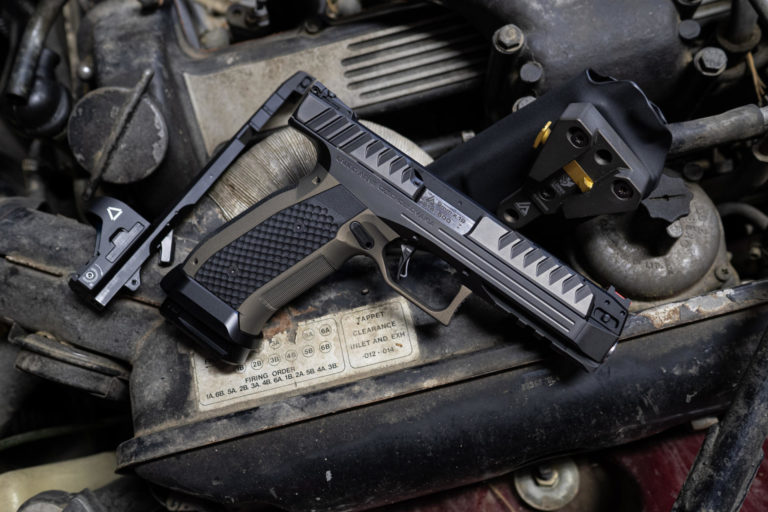
The Laugo Arms Alien pistol is the most important thing to hit the pistol market since Gaston Glock stopped selling blinds. Although not cheap with the entry-level model coming in at $5,000 and the fully-optioned “Alien Exclusive” package demanding a thousand more dollars, the Alien is so unique, so innovative and no objectively interesting as a handgun that it’s almost difficult to know where to start.
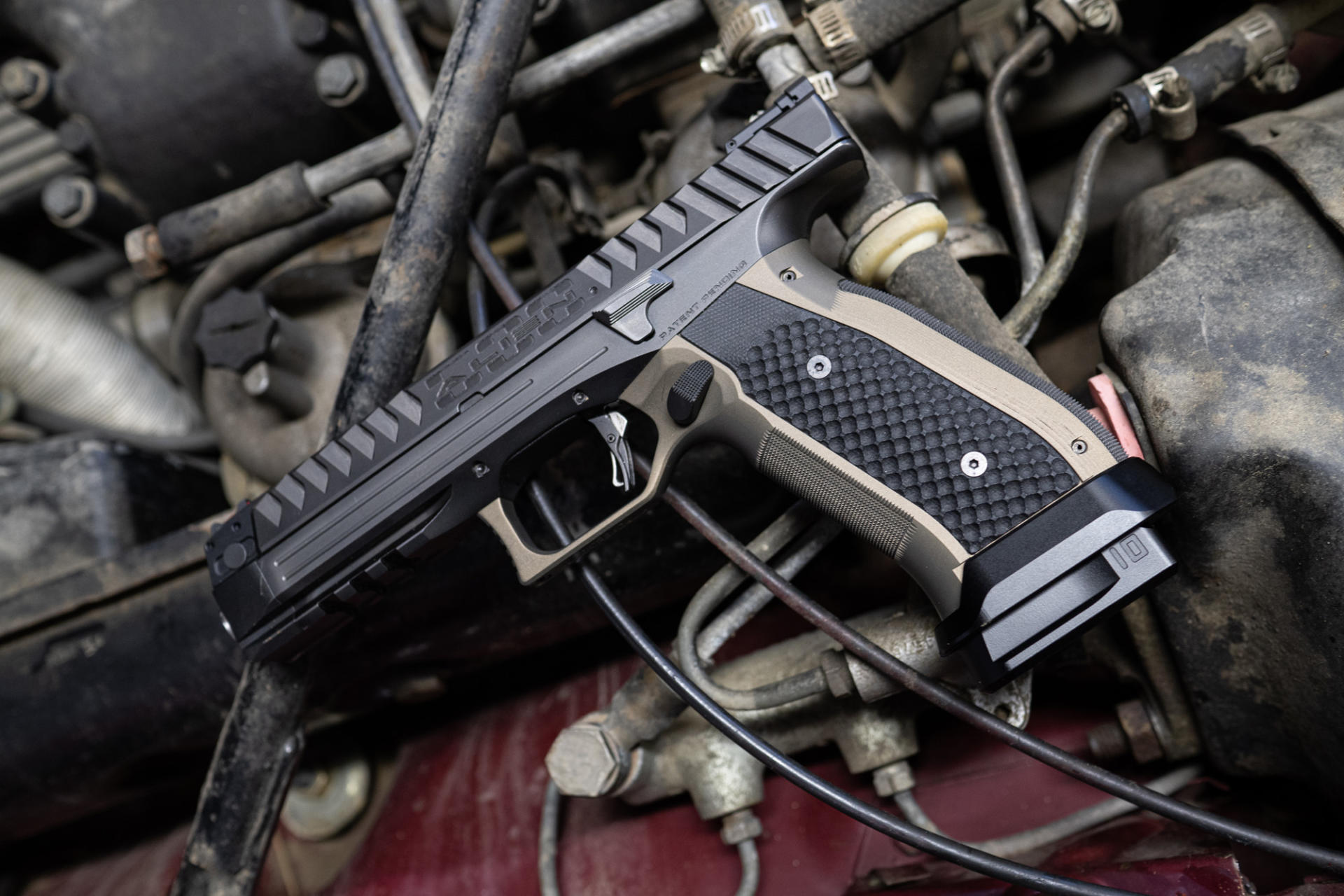
So why not start at the heart of the matter: What makes the Alien different. And without a doubt, that’s the action, first and foremost. For well over a hundred years, most semi-automatic handguns have leaned on the wisdom of John Moses Browning and adopted a design wherein the recoil of a round firing forces the slide and barrel to the rear. After some rearward travel in unison, the ramp or link interacts with an element of the frame and pulls the breech of the barrel downward. This allows it to disengage from the slide, bringing the gun out of battery and allowing the spent round to be ejected and the loading cycle to begin.
The Alien has no locking lugs, because the barrel and slide aren’t joined at all. The barrel is pinned to the frame by two roll pins located above the trigger, and the slide reciprocates around it in a fashion that’s best compared to that of a Browning Buck Mark or similar .22 pistol. And that’s not a coincidence, because like so many of those .22 pistols, the Alien is essentially a blowback-operated pistol - but not like any you’ve seen. See, inside a Laugo Alien you have three forces being harnessed at once; the familiar rearward recoil or blowback force and equally familiar forward force supplied by the recoil spring, with the addition of an equalizing force in the form of a forward-driving gas piston.
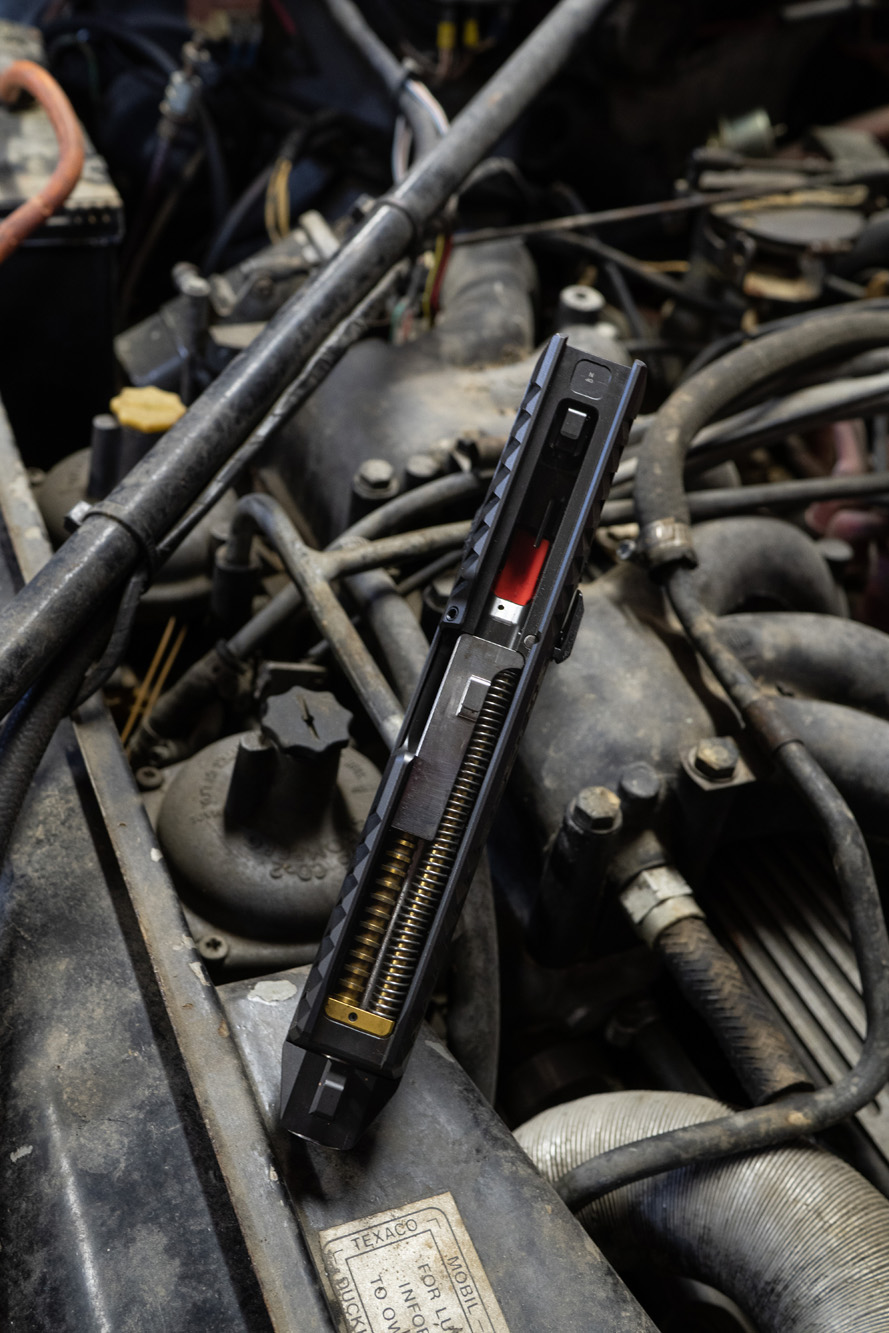
When the gun is fired, the extremely high chamber pressures act directly on the gas piston and essentially “lock” the slide and barrel together. Within milliseconds, chamber pressures drop to acceptable levels, and the pressure on the piston diminishes until such a time that the combined forward forces imparted on the slide by the gas piston and recoil spring are overcome by the rearward force of recoil. When this happens, the slide begins to move to the rear and the process of ejection occurs, as per normal. It’s also why the gun comes with different recoil springs; they’re used to tune the action’s operation around the ammunition being used. Hotter ammo requires a stiffer spring, and vice versa.
Now, to backtrack a bit, when I say “as per normal,” what I mean is that when the slide reciprocates, the action of ejecting the fired round occurs by way of a very conventional fixed ejector, and rounds are stripped out of the mag equally conventionally. But what isn’t conventional is wherein the gun this is happening. Because the entire reason Laugo employs such a complicated but mechanically beautiful action is that it allows them to move the recoil spring and “locking system” (such as the gas piston is) that normally resides below the barrel above it. This allows them to sink the barrel deeper in the frame, making for (reportedly) the lowest height-over-bore axis on the market. And I believe it; if you look at the side profile of the Laugo, and consider where the muzzle comes out, it’s pretty apparent; it’s basically where you’d expect to find a 1911’s guide rod.
Now, turning the action of a handgun sounds great; lower bore axis, shorter feed path, etc etc. However, there is one fly in the ointment: How do you fire it? When you consider that what’s visible through the ejection port is actually the gas cylinder, not the chamber, you realize the primer for the round you’re trying to fire is pretty much directly in line with your hand. That makes it pretty hard for a conventional hammer or striker assembly to get to. So, Laugo did what they clearly know best, and turned that conventional assembly upside down.

This brings us to the sight assembly, because that’s where you’ll find the Laugo’s hammer. Yes, you read that right. The Laugo is indeed hammer-fired, but the hammer is a sprung element that pivots downward to fire, rather than upward. It’s literally a conventional hammer, upside down, and hung from the sight rail. Interestingly, that sight rail itself is entirely removable, again inviting somewhat uncomfortable Browning Buck Mark comparisons. You simply push a captive pin out from under the front sight, give the rail a slight nudge forward and it lifts off entirely. This means going from sights to a micro-red dot, such as the $6,000 Alien Exlclusive package includes, is tool-free and accomplished in seconds. And concerns about zero? Well, Laugo’s taken care of that by having the slide rail hook onto interfaces above the rear of the frame, and the chamber, with the final connection point being that aforementioned captive forward pin. Furthermore, the centre interface point is sprung, and so provides both a detent to ease the sight rail’s installation and removal but also a degree of tension to keep the sight rail fixed in place.
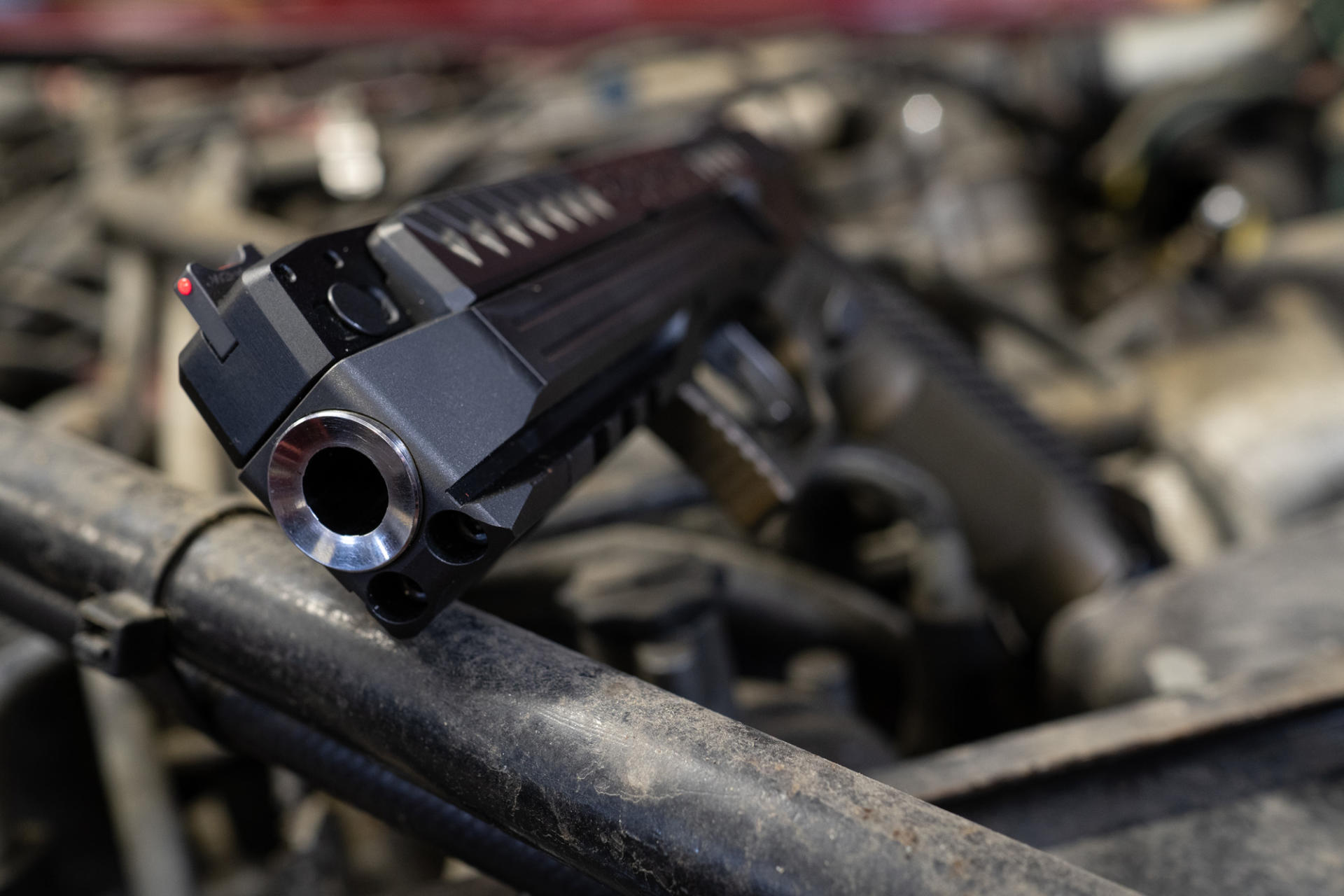
Which is yet another advantage of Laugo’s gun inversion experiment: The sights don’t move. Remember; the sights are pinned to the barrel and frame, neither of which move. The slide reciprocates around them. That means that the irons or micro red dot sights will be a lot easier to track across the board, as well as reduces wear and tear on electronic sights. Technically, it should also create for a more reliable platform for such sights as well, since you can’t bump the gun out of battery by knocking the sights against an IPSC barricade or otherwise, nor end up with a gun that runs poorly because of the increased reciprocating mass.
Now, there isn’t one Laugo Alien, there’s three: The Alien Exclusive, Performance, and Target. Pictured here is the Exclusive package, specifically a limited edition thereof that is individually numbered to identify it as one of the first 500 Aliens produced. At $1,000, it isn’t a cheap option, but it includes the installation of that aforementioned magazine well, as well as a very skookum Elornis carrying case and holster (that features a CNC-machined aluminium QD hanger and belt clip), three magazines, two sight rails (one with irons, one with a 6-MOA red dot mounted), a more powerful action spring, a small maintenance kit including cleaner and lube, and even a snap cap. And it’s all really, really nice stuff. The Performance model offers the same design benefits, sans the magazine well, spare magazines, magazine base pads, spare sight rail, holster and most tellingly, the FDE grip, opting instead for plain black nitride. There’s also a Target model that features a 6” barrel and removable frame extension with competition sights. Suffice to say, given it includes the spare sight rail (normally sold for $1,100), a 6-MOA red dot (pick your price), a $500 holster, and at least $250 worth of magazines and other accessories, suffice to say the Exclusive package seems to provide good value.
This is where the Laugo gets entirely predictable: How do you think a $6,000 clean-sheet redesign of the modern handgun shoots? To put it quite bluntly, it is likely the best shooting handgun made today. It has a significantly reduced reciprocating mass thanks to the unique and heavily rebated slide, the lowest bore axis in the world, and a fixed barrel and sights. Add to that the soft recoil impulse of the unique gas-buffered action and it reads like a list of things you want in the perfect handgun.
The grip is simply exquisite; there hasn’t been a person that’s laid this gun in their hand and not loved it. It’s perfectly shaped for the average mitt, and the fine line checkering on the front and back straps is appropriately aggressive for a race gun. The controls are all excellent, with a big mag release and the Exclusive model’s hugely bevelled magazine well making reloads as easy as they’ll ever be. One note though: At $89 a pop, these aren’t the sort of magazines you’ll necessarily want to just fling at the dirt willy nilly - at least not without perhaps wrapping in something.
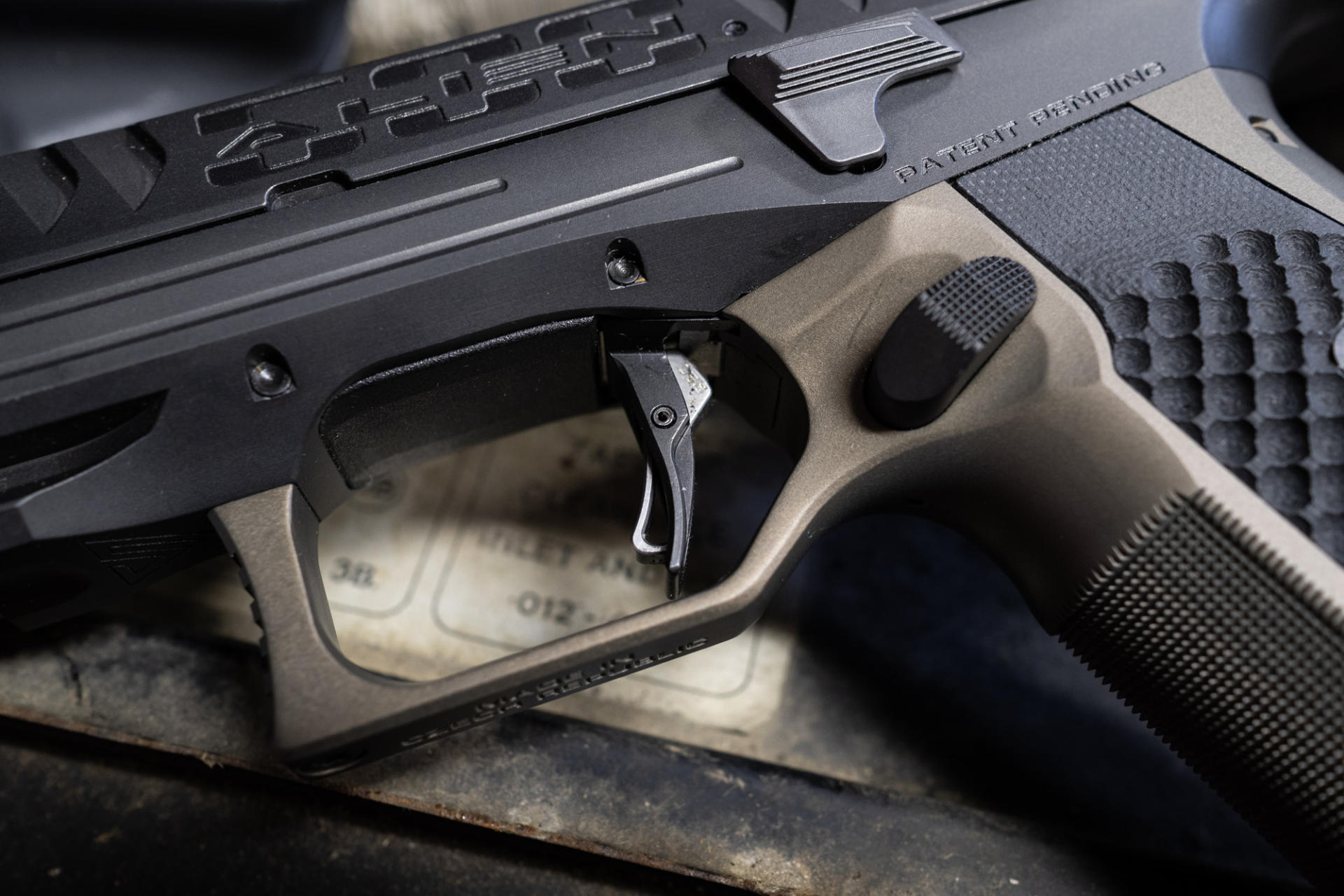
And the trigger? Well, it’s good. Really quite good. But there’s no getting around that there are a wee bit more clockworks going on inside the gun to transfer rearward pressure on the trigger into a bottom-swinging hammer releasing from a removable sight rail attached to the top of the gun. That is to say, it feels like a very good striker-fired trigger. Like a very good striker-fired trigger. But a 1911 snob would, well, be snobby about it. No getting around that. However, that Laugo’s managed to make a trigger that effectively makes a 180-degree turn and incorporates a removable component work this well is to be commended. Also, noting that the hammer and sear are both on the removable slide, trigger pull testing with both rails revealed that the trigger pull was largely consistent on average weight, but behaved differently depending on the sight rail fitted. With the red-dot sight rail, which has seen a lot more use, the trigger pull was very consistent; usually within a few ounces. On the iron sight rail the trigger pull was much less consistent, varying by a factor of about 2 or 3 times that of the red dot rail. It seems likely this could be attributed to wear, but nonetheless, with so much of the trigger mechanism on the rail, it’s something to be aware of - especially during maintenance.
And of course, with the fixed barrel and sights, it’s accurate. More accurate than me, that’s for dang sure. Muzzle flip is noticeably reduced, and between the excellent grip, good trigger, and top tier range manners it’s simply too easy to shoot. Like, literally, it’s too easy. It’s like having a cheat code for plate racks. It does get a little warm if you put three magazines through it as quickly as you can; no doubt the result the heavily reduced amount of mass around the chamber and the heat retained in the gas system. Of course, the upside of that reduced mass is that it cools down just as fast. You’d need five or more magazines to really make things uncomfortable, anyway.
I opened this review by saying in no uncertain terms that this is the most important gun since the polymer revolution led by Glock. I’ll repeat that here, and add some clarification: The design of the Alien should, in most logical worlds, be the future of all handguns. It is, in nearly all objective ways, better. Now, I want to say the inclusion of the gas system constitutes a complication and thus a potential failure point, but I can’t really do that with a straight face given I’ve been known to call a revolver reliable and their internals make the Alien look like an ameoba by comparison. So that pretty much leaves just the one downside: The price. At $6,000 it’s a bloody expensive gun, and it runs in company with names like Korth and Wilson Combat - and those aren’t exactly bad guns either. But if you’re the sort of guy that likes to be at the bleeding edge of tech, there can surely be no substitute.
